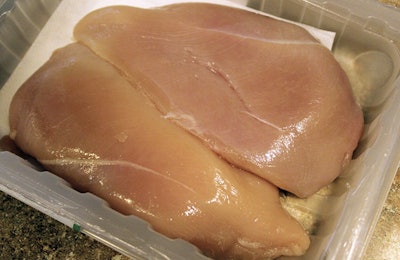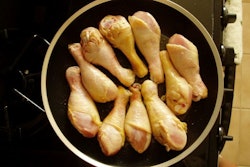
Breast meat myopathies have plagued the poultry industry for decades, but new approaches to further processing can create products that are more palatable to consumers, Parker Hall, VP of research, development and innovation, Perdue Farms, explained during Detection, prevalence, and utilization of myopathic chicken breast meat.
“We know we have woody breast, we know how to find it and now we know what to do with it,” Hall said.
About woody breast
One of the most common poultry breast meat myopathies is woody breast. Woody breast is a breast meat myopathy that affects the rigidity, texture and mouth feel of broiler meat. The breast meat may also be a pale color and soft in consistency.
Woody breast has become more common with the selection of fast-growing, heavier broilers, although the underlying cause of the condition is still a mystery. High temperatures during grow out, coccidiosis vaccination, source of chicks and hold time on lairage are also risk factors for breast meat myopathies.
“It’s a meat quality issue, not a public health concern and not pathogenic,” Hall said. “But it certainly influences consumers acceptance of meat products.”
Texture issues can include fibrousness, crunchiness and other unappealing attributes to consumers. Woody breast meat is typically discarded at the processing stage because of its undesirable attributes, resulting in large financial losses.
Prevalence of woody breast in U.S. broilers is declining but should remain a focus for the industry.
“We need to reduce more and/or find alternate use for and not have consumers disappointed,” he added.
Strategic positioning in processing
Woody breast and other meat quality defects don’t usually impact the entire fillet, so strategic portioning – where only part of the meat is sold – could make meat with the syndrome more valuable
Processing approaches that involve transverse slits of intermediate woody breast fillets can yield a usable bone side portion. The skin side is woody breast, however it may still have alternate uses in further processing applications.
Another potential solution is to use the breast meat in ground meat or further processed products, like sausages or hot dogs. This helps mitigate several of the textural issues that affect taste, particularly for fillets with severe woody breast.
In addition, Perdue experimented with chicken nuggets formulated with either 25%, 50% or 75% woody breast meat and found no significant statistical difference in choice, taste and flavor, although there were small noticeable differences in texture in a consumer survey. The study also found that meat with higher concentrations of woody breast yielded fewer nuggets than normal breast meat.
“As woody breast muscle inclusion increased, there is an increase in flavor, saltiness and moistness and a decrease in firmness, so it’s not all bad news,” Hall said.

















